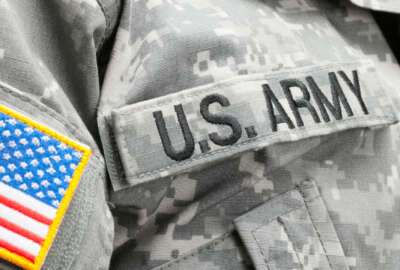
Panel recommends capping active Army force
The National Commission on the Future of the Army suggested keeping the active duty Army size minimum at 450,000 and increasing multi-component integration.
A congressionally appointed panel tasked with recommending modifications to the structure of the Army thinks a minimum of 450,000 active troops is sufficient to meet the nation’s national security objectives.
Along with accepting the Defense Department’s move to draw down the Army’s force size, the National Commission on the Future of the Army’s Jan. 28 report includes recommendations to retain and recruit talent in the Army and integrate multiple Army components.
The commission’s acceptance of a smaller Army force comes just a week after Army Secretary nominee Eric Fanning told lawmakers he was worried about the force readiness of the service.
Fanning told the Senate Armed Services Committee on Jan. 21 that the global threat situation made him second guess the decision to draw down the Army’s active duty force from 490,000 to 450,000 by 2018.
“The demand on the force, the size that it is makes it difficult to keep it trained,” Fanning said. “I do worry about the size of the Army today … two years ago [when we reduced the Army] to 450 [thousand troops] we didn’t have ISIL, we didn’t have Russia as provocative as it is, so I am concerned.”
Members of the commission also said they were concerned about the size of the Army, but they had to consider budgetary restrictions when making the recommendations.
“We were given specific parameters in our authorization to look at anticipated future resources and current resources versus an acceptable risk. Yeah, we’re worried, but given the resources we had we don’t see those numbers going up. We don’t have the money to increase the number of our soldiers,” Future of the Army Commission Vice Chairman Thomas Lamont told Federal News Radio.
The commission said the total Army size between active duty Army, Army Reserve and Army National Guard troops should be 980,000 and that the three components of the Army should be better integrated.
“Total force integration is not a new concept. … Over the past 45 years, the Army has explored several techniques for expanding on the total force policy and maximizing capacity in terms of numbers of units and readiness for the Army,” said Kathleen Hicks, the chairwoman of the commission’s operational subcommittee during a Dec. 17 meeting of the commission.
The commission recommended the Army add specific guidance on goals for future use of multicomponent units that blend active duty and other types of troops. The commission also wanted the Army to create a substantial pilot program to test multicomponent units on aviation units.
To ease the transition of soldiers between the three components, the commission wanted the Defense Department and the Army to support and fund the Integrated Personnel and Pay System-Army. Currently, the regular Army, Reserve and National Guard use three different personnel and pay systems. The commission wants the Army to integrate these services to ease the transition between components.
“What we’d all like to see is a continuum of service, where someone joins the Army, they don’t join a component,” Commissioner Jack Stultz said during a press briefing. “Over your career you may choose to go back and forth or the Army may choose to move you back and forth because your situation, your desires may change … the pay and personnel systems right now make that very, very difficult.”
The commission said it would like to see the National Guard personal system replaced in the second quarter of fiscal 2018, the regular Army and reserve replaced by the first quarter of 2019 and the establishment of one pay system for all components by the end of 2019. By the third quarter of 2020, the commission wants a unified evaluation and retention management system.
Integration can help with training and retention rates, the commissioners said. For further retention, the commission would like to see the Army retain formal leader development activities as a high priority for uniformed and civilian personnel. Over the years, those programs have been cut or truncated.
As a way of offsetting some of those costs, the commission suggested reviewing the Army School System and consolidating the infrastructure to gain efficiencies.
While that may help currently enlisted troops, the commission is rethinking how it will take on new ones. The different components are basically in charge of their own recruiting, with individual states responsible for recruiting for their National Guards.
According to the report, the recruiting population of 17-to-27-year-olds is shrinking despite nationwide population growth.
The commission wants the Army to have a unity of effort by letting recruiters enlist individuals into any component of the Army. The commission added it wanted the Army to consolidate the marketing functions of the three components.
“Multiple marketing efforts weaken the branding and inherently are less sufficient,” Stultz said.
Congress also tasked the commission with solving an issue regarding the allocation of Apache helicopters throughout the components.
When National Guard units in individual states began requesting Apache helicopters, it started debate on the roles of National Guard and regular Army aviation roles.
The commission looked at “what is the role of the Army National Guard in providing for external national defense and not just at the borders inside?” said Dakota Wood, a senior research fellow at the Heritage Foundation. “How does the Army Reserve play into this?”
The panel solved those questions by giving the regular Army 20 battalions of 24 manned Apache aircraft and the National Guard four battalions of 18 aircraft.
“The plan adds only two Black Hawk battalions to the Army National Guard. The Army should commit to using the four Army National Guard Apache battalions regularly,” the report states.
The report stated the solution gives wartime surge capacity by maintaining the four battalions in the National Guard.
Members of the commission said they have given the report to DoD and have received a polite and respectful response.
The Army said it is currently assessing the report and expects “its recommendations to provide opportunities to strengthen the effectiveness of” the force.
The Army secretary and the Army chief of staff will lead the Army’s assessment process, which will include efforts by the director of the Army National Guard and the Army Reserve chief, the release stated.
“The Army’s evaluation of costs, benefits and risks outlined is now just beginning,” the release stated.
Gus Hargett, president National Guard Association of the United States said in a statement, “The commission sees the Army National Guard continuing as a full partner in our Army, including attack aviation. It also sees a need for greater integration among components. We certainly agree.”
Harget goes on to say NGAUS does not expect to agree with every recommendation, but welcomes discussion.
Copyright © 2024 Federal News Network. All rights reserved. This website is not intended for users located within the European Economic Area.
Scott Maucione is a defense reporter for Federal News Network and reports on human capital, workforce and the Defense Department at-large.
Follow @smaucioneWFED




